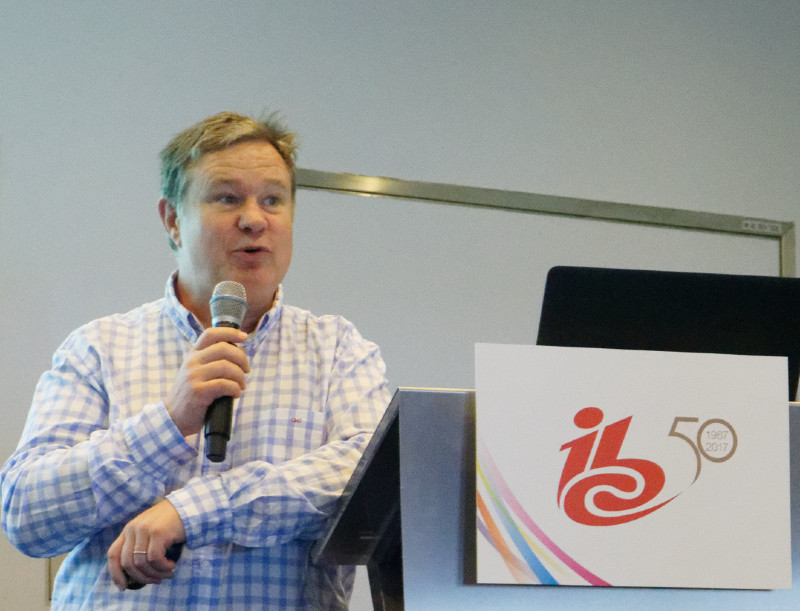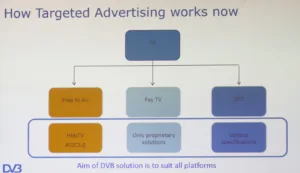 The DVB held its traditional IBC press event on the Friday afternoon – the same 3.00pm procedure as every year.
The DVB held its traditional IBC press event on the Friday afternoon – the same 3.00pm procedure as every year.
Peter MacAvock of the EBU started the presentation by saying that the industry is changing. HDR is coming and becoming mainstream but it’s still hard to do in a live production environment. UltraHD resolution is now mainstream in production but needs to be more cost effective. Broadband delivery remains the key challenge – how to get UltraHD content across the internet.
DVB now has greater transparency on its activities and anyone can see the workplans, now. The group has been working on the relationship with HbbTV and that technology is getting more important and has become a core element of DVB.
The current DVB processses are a bit complicated and the group is looking at improving them.
Thierry Fautie is from Harmonic and he is chair of the targeted advertising group
Both HbbTV and ATSC 3.0 can support targeted advertising (ATSC allows targeted ads based on ip). The current situation is tricky – Pay TV is all proprietary and OTT is the ‘wild west’, Fautie said. DVB wondered if it could make a platform to address all the needs.
Targeted advertising is important and DVB is looking to exploit the HbbTV specification
DVB planned to report on the topic in the week after IBC then there will be the development of commercial requirements (in accordance with the usual DVB process) and the plan is to finalise commercial requirements by mid 2018. The group will then develop specifications and a technical module by 2020. After that, the aim will be to make it a market reality.
There is an Adaptive Bitrate Multicast commercial group which is working to scale live adaptive streaming to solve the problems of big OTT projects. (one of the recurrent themes of the event was that large live OTT events continue to be problematic, regardless of the claims of CDN providers. – Man. Ed.)
The first test case is the use with Docsis (cable technology) and the challenge is to go across all networks. The really hard part is dealing with unmanaged networks. The group is now developing the technical module and it may be available in early 2018, perhaps, but unmanaged networks are very tricky.
Sport events are currently a challenge but this technology could be a solution both technically and could help the business develop.
VR has Many Companies Involved
 The next speaker was David Wood (who attended his first IBC in 1974 – it started in 1967 and was celebrating 50 years of IBC) who has been a key part of the development of UltraHD in Europe. He is Chair of the CM-VR-SMG Commercial Module which is looking at the options for VR with 6 degrees of freedom (DOF) (where the user can move inside a virtual world). It is also looking at the commercial requirements for VR with three DOF (where the user can look around a 360 video, but cannot move the viewing position).
The next speaker was David Wood (who attended his first IBC in 1974 – it started in 1967 and was celebrating 50 years of IBC) who has been a key part of the development of UltraHD in Europe. He is Chair of the CM-VR-SMG Commercial Module which is looking at the options for VR with 6 degrees of freedom (DOF) (where the user can move inside a virtual world). It is also looking at the commercial requirements for VR with three DOF (where the user can look around a 360 video, but cannot move the viewing position).
Wood said that there are 50 groups and committees so far involved in developing standards for VR and that makes things very challenging from a standardisation point of view. To help sort this out, there will be a world VR coordination meeting in December 2017 – and most groups are likely to be there including the DVB.
DVB is considering two categories of VR
- Type A is Untethered and is based on using a smartphone in an optical container and the CM-VR group is developing commercial requirements with B<>Com in France.
- Type B is for dedicated headsets that are connected to PCs or consoles and at the moment, the DVB is ‘investigating the landscape’ for discussion about approaches at a possible workshop in Feb 2018.
Moving onto UltraHD TV, there is a lot of interest in HFR and HDR at FullHD resolution, which would look good even on the smaller sets that are popular in Europe. However, there are several features in UltraHD Phase 2 – HDR, HDR, WCG and Wood asked how do you decide which features to include? HUHD TV-1 is moving well and there is a discussion about new systems for HDR support such as dynamic metadata in HDR10+. The DVB is also looking at adding more Next Generation Audio (Phase 1 includes Dolby AC-4 and MPEG-H) to the toolbox.
DVB Booth Demos
Peter Siebert then explained the demos on the DVB booth. The first was an HDR and HFR prototype using 1080P at 100Hz which Siebert said may be good for DTT where UHD resolution is not possible. HLG10 is being used on the demo.
IRT is showing different adverts according to the ip address of the receiver.
In Sat>IP, unusually, there is a repeat of a demo. The Sat>IP alliance is now liaising with DVB and, in the future, DVB will control the standardisation and technical development, while promotion will be by both SAT>IP and DVB.
DVB will use the specification to develop a more generic version of SAT>IP for moving video around within the home. Sat>IP is not really just about satellite, Siebert said. An example of a potential problem is that swtiches are not multicast, so you have to bypass them.
Siebert said that there are new harmonised EU privacy regulations. They mean that users have to opt in for data collection and that will have a big impact on service providers and brand vendors. The GDPR (General Data Protection Regulation) regulations – will a big issue, to meet them, you have to have a particular structure and that will be a challenge for many.
 The DVB Panel was from L to R, Peter MacAvock, Peter Siebert and Thierry Fautie. Image:Meko
The DVB Panel was from L to R, Peter MacAvock, Peter Siebert and Thierry Fautie. Image:Meko
Questions
DVB World will go to Warsaw on 12th 14th March.
In response to a question about digital radio, Siebert said that there are challenges DAB, for example, how to harmonise the switch off of FM (or do you do it all?). There was a dream in digital radio of being able to drive from the South West of Europe to the North East with digital radio service being received seamlessly. That’s looking very unlikely not, but going from the North West to South Eat might be possible.
Hybrid radio (combining broadcast, whether FM, HD, DAB or DAB+, with internet audio) is a challenge and is needed for better performance. Hybrid radio enables data to be shown alongside audio content. Ideally, DVB and radio operators would like to see a consistent user experience in broadcast and online, FM and the varieties of DAB.
Responding to another question, it was confirmed that MPEG-H NGA will be used in Korea for its ATSC 3 implementation. AC4 (Dolby) has been offered as a standard and DTS has also submitted a proposal for inclusion to the ITU. ITU is talking about a single renderer. (there could be a fourth proposal, MacAvock let slip – we heard elsewhere that this could be something from the BBC, but we didn’t dig into it).
In looking at HDR10+ and Dolby Vision, Wood said that private or public metadata is the question?
Analyst Comment
We heard just before IBC that Apple’s new phones would support HLG as well as HDR10 and Dolby Vision. We heard from a codec maker at IBC that there is a lot of interest in broadcasting to the Apple TV and TV app, in a simulcast alongside broadcast. That means that HLG is a very much preferred option.

